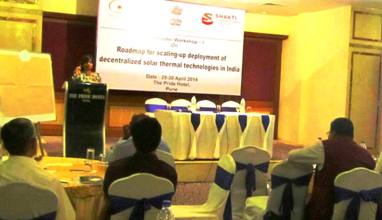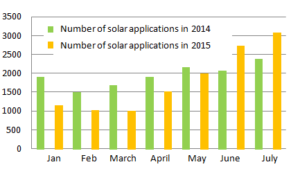India: First Stakeholder Workshop for Solar Thermal Roadmap
May 17, 2014
 Whereas India shows enormous demand for thermal energy in the industry and for cooking, solar thermal has so far only covered 0.2 % of the total heating and cooling need. Therefore it is urgent to scale up the use of decentralised solar thermal technologies. Supported by the Shakti Foundation, consultancy Greentech Knowledge Solutions (GKSPL), located in New Delhi, will prepare a roadmap for scaling up deployment of decentralised solar thermal technologies in India. With plans to publish the roadmap by October 2014, GKSPL organised the first stakeholder workshop in Pune at the end of April, gathering around 40 experts mainly from the solar thermal manufacturing business.
Whereas India shows enormous demand for thermal energy in the industry and for cooking, solar thermal has so far only covered 0.2 % of the total heating and cooling need. Therefore it is urgent to scale up the use of decentralised solar thermal technologies. Supported by the Shakti Foundation, consultancy Greentech Knowledge Solutions (GKSPL), located in New Delhi, will prepare a roadmap for scaling up deployment of decentralised solar thermal technologies in India. With plans to publish the roadmap by October 2014, GKSPL organised the first stakeholder workshop in Pune at the end of April, gathering around 40 experts mainly from the solar thermal manufacturing business.Photo: Jaideep Malaviya
According to basic research undertaken by GKSPL, heating and cooling makes up 64 % of the total thermal energy of 421 million tonnes of oil equivalent (Mtoe) used in India. The two main sectors are industrial process heating (61 % of the aforementioned share) and cooking with 38 %; 28 % of the process heat requirement is below 250 ˚C. The cumulative capacity of decentralised solar thermal in India installed until December 2013 was nearly 5 GWth, comprising 7.2 million m² of solar collectors, about 40,000 m² of solar concentrating systems, 700,000 units of solar cookers and nearly 10,000 m² of solar air heaters. Hence, the technology accounts for 0.2 % of the total heating and cooling need. According to estimations by the Indian government and GKSPL, energy demand in the cooking sector is expected to increase fivefold and the one of industrial heating, ventilation and air-conditioning (HVAC) is expected to increase 7.5-fold by 2032.
Six strategic focus areas
During the first part of the stakeholder workshop, the organisers presented the basic structure of the roadmap, which consists of six strategic focus areas:
- Expand the market of established solar heating solutions for single- and two-family homes
- Develop additional market segments by gaining new expertise
- Concentrate on industrial process heat up to 100 ˚C
- Focus on cost-effective solutions
- Give priority to collaborative research on cost-reducing measures
- Campaign for a favourable policy framework
The study will also cover four broad sectors:
- Residential, including urban and rural households requiring hot water for cooking and showering
- Commercial offices, hotels, hostels, guest houses, hospitals, and religious places requiring hot water for cooking, showering and process heat
- Industries requiring hot water for industrial processes
- Agricultural businesses requiring heat for drying and cold for storage
During the discussion, the stakeholders identified the following major requirements across all four sectors – residential, industrial, commercial and institutional, and agricultural:
- Regarding the residential sector, the participants suggested a special focus on awareness-raising, ensuring enforcement of municipal regulations on solar water heaters, technology advancement and product reliability. Medium- to low-density urban areas should become the centre of attention due to their higher per capita rooftop space compared to high-density areas. But to establish solar thermal as a mainstream product, it also requires distribution strategies for these urban areas.
- To ensure increased solar thermal use in industries, solar thermal system suppliers need to improve the credibility of solar system systems by making performance data available to the public (eg, on a website) and by introducing third-party certification. Other support measures that concern this sector are the provision of loans at low-interest rates and the establishment of framework models to encourage ESCOs. The industry representatives expressed their desire to reduce costs by means of R&D and eliminate all forms of taxes on raw materials required for production. There was also a call for mandatory regulation (eg, solar bye-laws) when using solar thermal in industries with tradable performance mechanisms.
- Concerning the commercial and institutional sectors, the crucial factor is the successful development of cooking solutions with economical steam storage technologies. This will enable the end user to utilise the solar system’s energy at nighttime, therefore improving the system’s utilisation rate. There was a question mark over solar cooling becoming a viable substitute for existing cooling technologies due to technological limitations, lack of sufficient space and high payback periods. The challenge here would be to improve the coefficient of performance (COP) of the vapour absorption chillers to enhance output and payback periods. Another important improvement could be the sale of hybrid cooling systems using liquefied petroleum gas (LPG) and solar to ensure energy is available even when the sun is not. The barriers to the establishment of ESCOs were said to be a lack of easy financing, as well as cost-effective and reliable energy measurement systems. Model contracts would be required to facilitate agreements between ESCOs and end users.
- In the agricultural sector, a rough estimate points out that the lack of drying facilities results in annual losses of about INR 1 trillion because of inedible food. Therefore, solar drying should play a larger role in food preservation, and the development of micro low-cost solar conduction driers could open up many new application areas.
More information:


